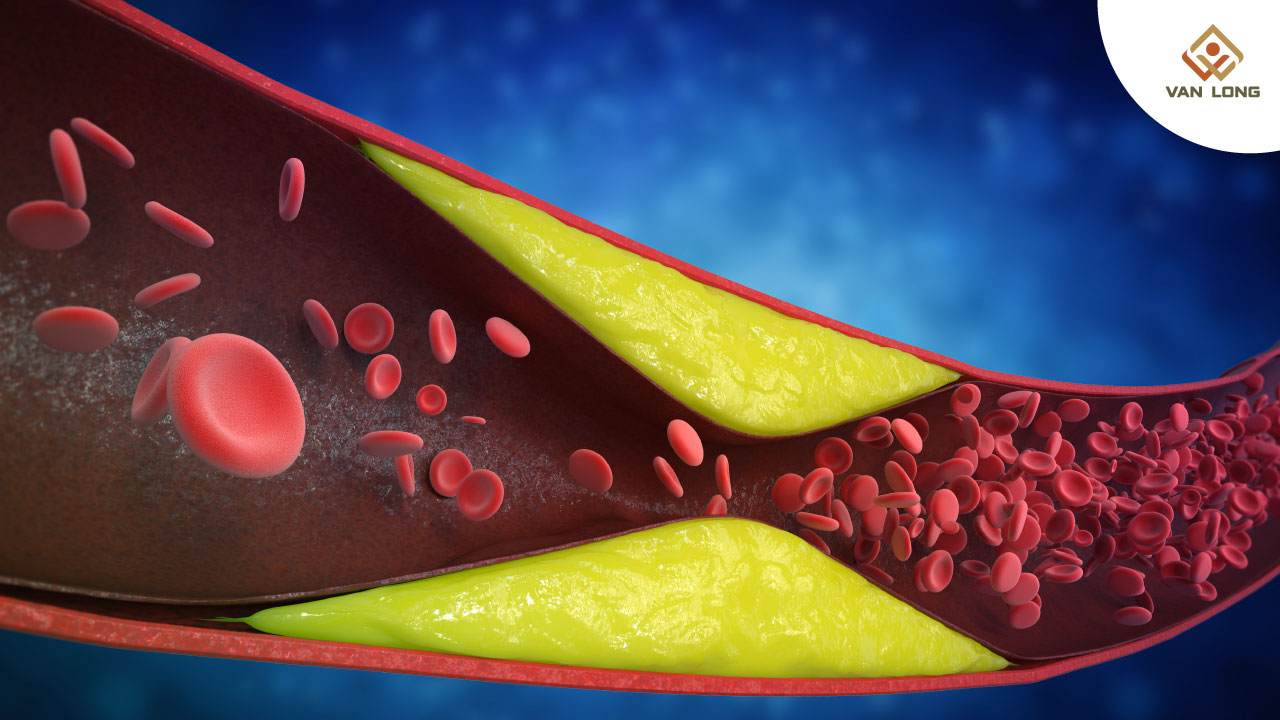Xơ vữa động mạch là tình trạng tích tụ mảng bám bên trong thành động mạch. Những mảng này hình thành từ chất béo, cholesterol, tế bào chết, mô liên kết và canxi, khiến lòng mạch bị thu hẹp và cứng lại theo thời gian. Từ đó, lưu lượng máu giảm, khiến các cơ quan như tim, não, thận… thiếu oxy và dưỡng chất cần thiết.
Điều nguy hiểm là xơ vữa thường tiến triển âm thầm. Khi phát hiện ra thì mạch máu đã bị tắc nghẽn nghiêm trọng, gây ra nhồi máu cơ tim, đột quỵ, suy tim, hoặc tổn thương vĩnh viễn các cơ quan.
1. Cơ chế hình thành mảng xơ vữa

Quá trình xơ vữa không xảy ra một cách đột ngột mà diễn ra theo nhiều giai đoạn:
- Ban đầu, lớp nội mạc mạch máu bị tổn thương do các yếu tố như huyết áp cao, đường huyết cao, cholesterol cao, khói thuốc…
- Tại vị trí tổn thương, tiểu cầu và đại thực bào tập trung lại để “sửa chữa”, vô tình kéo theo sự tích tụ LDL-C (cholesterol xấu).
- Đại thực bào “ăn” LDL-C sẽ biến thành tế bào bọt, hình thành vệt mỡ.
- Theo thời gian, các vệt này dày lên, vỡ ra, gây viêm và tạo điều kiện cho mảng xơ vữa cứng lại, gây hẹp lòng mạch hoặc tắc hoàn toàn nếu hình thành cục máu đông.
2. Các vị trí động mạch dễ bị xơ vữa

Xơ vữa có thể ảnh hưởng đến bất kỳ động mạch nào trong cơ thể, nhưng phổ biến nhất là:
- Động mạch vành (nuôi tim) → gây đau thắt ngực, nhồi máu cơ tim
- Động mạch não → gây thiếu máu não, đột quỵ
- Động mạch cảnh → ảnh hưởng trực tiếp đến cung cấp máu cho não
- Động mạch chủ → dễ dẫn đến phình hoặc vỡ động mạch
- Động mạch chi dưới → dẫn đến thiếu máu nuôi chi, hoại tử
3. Triệu chứng cảnh báo xơ vữa động mạch
Ở giai đoạn sớm, bệnh thường không có triệu chứng rõ ràng. Tuy nhiên, khi mạch máu đã bị ảnh hưởng nghiêm trọng, bạn có thể nhận thấy:
Liên quan đến tim:
- Đau ngực, tức ngực
- Khó thở, đặc biệt khi gắng sức
- Rối loạn nhịp tim
- Mệt mỏi kéo dài
Liên quan đến não:
- Đột ngột mất thăng bằng
- Nói ngọng, méo miệng, liệt nửa người
- Suy giảm trí nhớ, rối loạn nhận thức
Liên quan đến tứ chi:
- Đau, chuột rút khi đi lại
- Da chân lạnh, nhợt nhạt
- Vết thương lâu lành, dễ loét
4. Biến chứng nguy hiểm nếu không điều trị sớm

Xơ vữa động mạch là nguyên nhân hàng đầu dẫn đến các bệnh lý tim mạch nghiêm trọng, bao gồm:
- Nhồi máu cơ tim cấp: do tắc động mạch vành
- Đột quỵ thiếu máu não: do mảng bám vỡ ra tạo cục máu đông chặn dòng máu lên não
- Suy tim: do tim làm việc quá sức lâu ngày
- Tổn thương thận, ruột, chi dưới: do thiếu máu nuôi cơ quan
Đây cũng là nguyên nhân gây tăng huyết áp mạn tính – một trong những dấu hiệu thường gặp mà bạn có thể phát hiện sớm bằng máy đo huyết áp tại nhà.
5. Đo huyết áp định kỳ – Chìa khóa để phát hiện sớm rối loạn tim mạch
Đo huyết áp đều đặn giúp:
- Phát hiện sớm tình trạng tăng huyết áp không triệu chứng – yếu tố nguy cơ trực tiếp gây xơ vữa
- Theo dõi hiệu quả điều trị nếu bạn đang dùng thuốc hạ áp hoặc kiểm soát cholesterol
- Nhận diện nhanh những bất thường trong nhịp tim, chỉ số huyết áp tâm thu và tâm trương
Việc sở hữu một máy đo huyết áp điện tử tại nhà giúp người bệnh chủ động theo dõi sức khỏe hàng ngày, đặc biệt là người cao tuổi, người có bệnh nền tim mạch, tiểu đường, thừa cân…
6. Nguyên nhân và yếu tố nguy cơ gây xơ vữa động mạch

Nguyên nhân chính:
- Cholesterol cao (đặc biệt là LDL-C)
- Tăng huyết áp mạn tính
- Đái tháo đường
- Viêm mãn tính (lupus, viêm khớp, vảy nến…)
- Hút thuốc lá, khói thuốc thụ động
- Chế độ ăn nhiều chất béo bão hòa, ít rau củ
- Ít vận động thể chất
- Stress, lo âu kéo dài
Yếu tố nguy cơ:
- Tuổi cao (trên 55 tuổi)
- Di truyền (gia đình có người mắc bệnh tim sớm)
- Béo phì, thừa cân, đặc biệt là béo bụng
- Lười vận động thể chất
- Lạm dụng rượu, bia
7. Chẩn đoán xơ vữa động mạch bằng phương pháp nào?
Để xác định chính xác tình trạng xơ vữa, bác sĩ có thể chỉ định:
- Xét nghiệm máu: kiểm tra mỡ máu, đường huyết, CRP…
- Điện tâm đồ (ECG), siêu âm tim
- Chụp CT mạch vành, MRI hoặc chụp cộng hưởng từ não
- Siêu âm Doppler động mạch cảnh, chi dưới
- Đo chỉ số ABI (chỉ số mắt cá – cánh tay) để phát hiện sớm bệnh động mạch ngoại biên
8. Các phương pháp điều trị xơ vữa động mạch

Không thể chữa khỏi hoàn toàn xơ vữa, nhưng hoàn toàn có thể kiểm soát và làm chậm tiến triển của bệnh bằng các phương pháp sau:
Thay đổi lối sống:
- Tăng cường vận động thể chất
- Ăn uống khoa học, giảm muối, giảm đường, giảm chất béo bão hòa
- Giữ cân nặng ổn định
- Cai thuốc lá, hạn chế rượu bia
- Kiểm soát stress
Dùng thuốc:
- Statin, Fibrate: giảm cholesterol máu
- Thuốc hạ áp: như ACEI, ARB, thuốc chẹn beta
- Thuốc chống kết tập tiểu cầu: aspirin, clopidogrel
- Thuốc chống đông: heparin, warfarin nếu có chỉ định
Can thiệp ngoại khoa khi cần:
- Đặt stent, nông mạch vành
- Phẫu thuật bắc cầu mạch vành
- Lấy bỏ mảng bám, điều trị tan huyết khối
9. Phòng ngừa xơ vữa động mạch: Việc cần làm mỗi ngày
Lối sống lành mạnh:
- Tập thể dục đều đặn ít nhất 150 phút/tuần
- Ngủ đủ giấc (7–8 tiếng/ngày)
- Tránh căng thẳng kéo dài
- Duy trì tâm trạng tích cực
- Đo huyết áp định kỳ bằng máy đo huyết áp điện tử tại nhà để phát hiện bất thường
Dinh dưỡng hợp lý:
- Ăn nhiều rau xanh, trái cây, ngũ cốc nguyên hạt, cá béo, sữa ít béo
- Giảm tối đa muối và đường
- Ưu tiên chất béo tốt từ dầu thực vật, quả bơ, các loại hạt
- Hạn chế tối đa thực phẩm chế biến sẵn, đồ chiên rán, nước ngọt
10. Khi nào nên đến gặp bác sĩ?

Nếu bạn có những dấu hiệu sau, đừng chủ quan, hãy đi khám sớm:
- Đau ngực, đau đầu không rõ nguyên nhân
- Tê yếu tay chân, mờ mắt đột ngột
- Khó thở khi gắng sức
- Huyết áp thường xuyên cao, dao động bất thường dù đã nghỉ ngơi
- Đã từng bị đột quỵ nhẹ, thiếu máu não, đau tim
11. Chủ động phòng ngừa để sống khỏe mỗi ngày
Xơ vữa động mạch là một bệnh lý nguy hiểm nhưng có thể phòng tránh được nếu bạn duy trì lối sống khoa học, tập thể dục đều đặn, ăn uống hợp lý và theo dõi sức khỏe định kỳ. Đo huyết áp tại nhà với thiết bị phù hợp, nhất là máy đo huyết áp điện tử, là một trong những hành động đơn giản nhưng hiệu quả để nhận diện sớm các rối loạn tim mạch, từ đó can thiệp kịp thời trước khi biến chứng nguy hiểm xảy ra. Hãy chủ động bảo vệ sức khỏe tim mạch ngay hôm nay – vì một cuộc sống khỏe mạnh và an yên lâu dài.
——————————
CÔNG TY TNHH PHÁT TRIỂN THƯƠNG MẠI DỊCH VỤ VÂN LONG
YOUR NEEDS - OUR BUSINESS
-
Hotline: (028) 3526 2468 / 098.484.0440
-
Email: cskh@vl-groups.com
-
Website: www.vl-groups.com
-
Địa chỉ:
- Văn phòng HCM: Tòa nhà Fosco, D35 + D36 - 40 Bà Huyện Thanh Quan, P.Xuân Hòa, TP. HCM
- Trung tâm bảo hành: 373/14 Nguyễn Kiệm, P.Đức Nhuận, TP.HCM
- Văn phòng Hà Nội: Khu VP Hồng Hà, 38.3/1 Ngõ 109 Trường Chinh, P.Phương Liệt, Q.Thanh Xuân, Hà Nội
- Kho Tổng: 938 Quốc Lộ 1A, P.Linh Xuân, TP.HCM
🌼 Shopee: https://shopee.vn/vanlonggroups
🌼 Tiktok: https://www.tiktok.com/@thietbichamsocsuckhoe
🌼 Tiki: https://tiki.vn/cua-hang/cham-soc-suc-khoe-van-long
🌼 Lazada: https://www.lazada.vn/shop/van-long-our-needs-your-business





